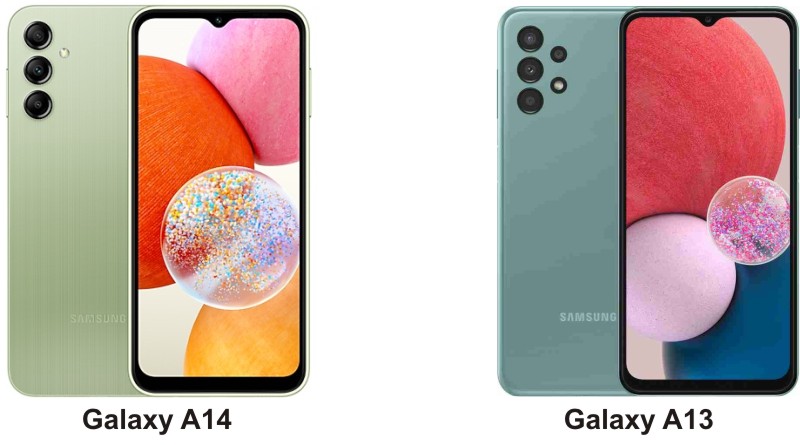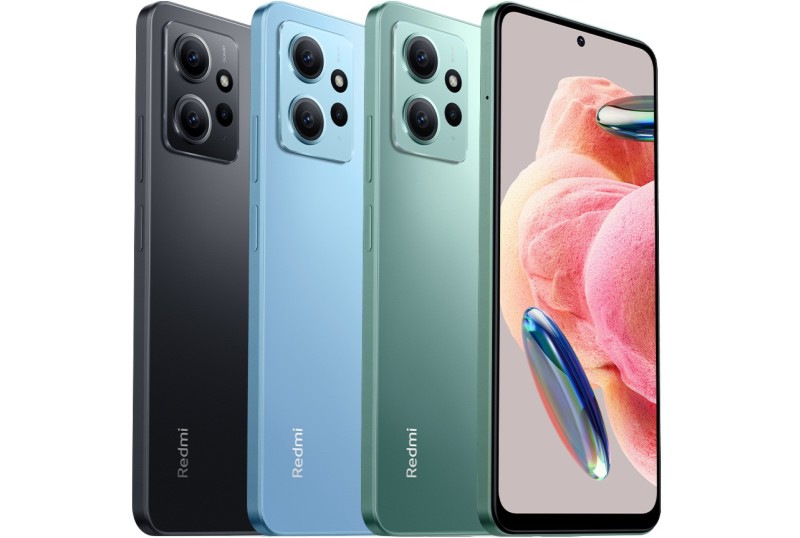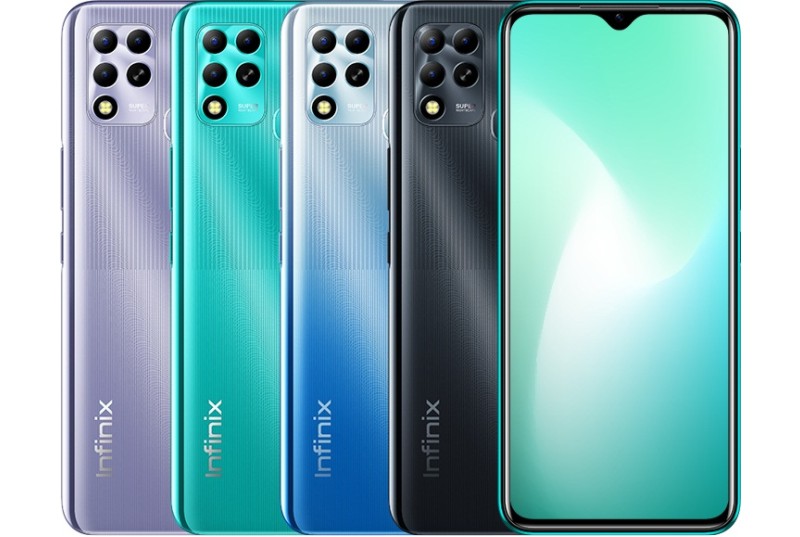Samsung Galaxy A14 4G (SM-A145F) Price, Review And Specifications.
Tweet
STORAGE
Tweet
Samsung Galaxy A14 4G (SM-A145F) Quick Specs:
6.6" Full-HD+ (2408×1080) PLS-LCD 60hz Infinity-V Display.
400ppi, 20:9 Aspect Ratio.
Exynos 850 Chipset.
Android 13 OS, Samsung One UI 5.1 Core.
Triple-lens (50MP+5MP+2MP) Rear Camera.
Single-lens (13MP) Front Camera.
4GB/6GB of RAM (And up to 4GB Virtual RAM).
64GB/128GB Internal Storage.
Face Recognition.
Fingerprint reader (Side-mounted).
USB Type-C Port:
4G (LTE) Network.
5000mAh Battery (15W Fast Charging).
Starting Price:
₦115,000, $148, £130, GH₵ 1,634, EGP 5,249, R 3,289, KSh 21,699, UGX 567,000.
If you're in the market for an affordable sleek looking phone with all encompassing features, Samsung Galaxy A14 4G (SM-A145F) won't win you over. But if you're looking for the one with an attractive display, good build quality, impressive cameras and futuristic OS upgrades, you might want to check out Samsung Galaxy A14 4G.
Design-wise, the new Samsung Galaxy A14 comes in the usual form factor and sports the familiar Invinity-V (water-drop notched) display; the looks that's among the Samsung budget phones, especially the ones at this price point.
In short, the latest phone looks almost like its predecessor, Samsung Galaxy A13, and the recent Samsung Galaxy A04s.
Yet, A14 still managed to look different from those two phones by having all-flat back cover and flat edges. And the slight modifications cause the latest phone to look boxier and more premium than the earlier model, and the rest of its siblings.
Apart from its more premium looks, another main thing that distinguished Galaxy A14 from the A13 is its higher megapixel front camera. Otherwise, A14 retain almost all other features of the A13.
For instance, despite the fact that the latest phone is pre-installed with the latest Android OS and the latest version of One UI Core, the phone still packed the same hardware components as the earlier phone.
Even, one or two features of the earlier model has been downgraded on the Galaxy A14. For instance, the earlier phone's Quad rear camera has been downgraded to Triple-lens on the A14.
By the way, Samsung Galaxy A14 is available in four variants, and all of them has different chipsets.
The first two (out of the four) variants are powered by 5G processors. And these are Exynos 1330 powered Galaxy A14 5G and MediaTek Dimensity 700 powered Galaxy A14 5G.
The other two variants are powered by 4G processors. And these are MediaTek Helio G80 powered Galaxy A14 and Exynos 850 powered Galaxy A14.
Basically, the type you get depends on your region or location. The last variant i.e., Exynos 850 powered Galaxy A14, is found in this region and it's the focus of this review.
Comparing Galaxy A14 to the Galaxy A13:
Meanwhile, in spites of its more premium looks, the protective Corning Glass 5 that's Infront of the earlier model is missing on the Galaxy A14. Yet the phone still features an identical 6.6-inch Infinity-V PLS-LCD display. And the screen still has the same 1080p resolution. The screen also maintain the clarity and rich colours of the earlier one, even the latest screen look slightly more vibrant. Unfortunately, the screen still lack high refresh rate like the earlier one.
On the camera setup. The back of the Samsung Galaxy A14 is mounted with a 50-megapixel triple rear camera; a reduction from the 50-megapixel Quad rear camera of the earlier model.
On the other hand, the 8-megapixel selfie lens on the front of the Galaxy A13 has been upgraded to 13-megapixel lens on the Galaxy A14.
And despite that both the front and rear cameras are able to maintain unrivaled nice looking shots like the earlier ones, the shots from the latest phone still look slightly better and also has better white point. Which i think it has something to do with latest phone's updated software.
And speaking of the software. Samsung Galaxy A14 is pre-installed with the recent Android 13 OS with the latest Samsung One UI 5.1 Core on top. Though, it should be known, that the software on the earlier Galaxy A13 can also be upgraded to the same Android OS and the same One UI Core version.
Except for those few changes, the rest of the Samsung Galaxy A14 features are exactly like those of the Galaxy A13. Because The latest phone features the same CPU, RAM, storage capacity, battery capacity, fast charging and so on, as the earlier phone.
Comparing Galaxy A14 To Others In This Segment:
Firstly In term of looks, there are others in this segment that offer better design than this phone. For instance, Tecno Spark 10 Pro looks more sleeker than the Galaxy A14, so also Xiaomi Redmi Note 12 4G. But as expected, Galaxy A14 has a solid, butter build and durable chassis. Though the Redmi phone also has a good build quality too.
Also, in spite of its lack of high refresh rate, the 6.6-inch PLS-LCD 1080p display of the Samsung Galaxy A14 was able to render a more vibrant colours and clearer pictures than many of its competitions with an average IPS-LCD panels.
Apart from its better build quality and nice-looking display, another selling point of the Galaxy A14 is the cameras.
Photos from the 50-megapixel triple rear camera of this Samsung phone look quite impressive for a phone at this price point. Photos are clear, sharp and detailed with true to life colours.
The 13-megapixel front-facing camera of the phone also delivered a more clearer and more realistic selfies than most of others at this price point with higher megapixel selfie lenses.
Under the hood, there's no much difference between the processing power of the phone and those of its rivals.
The Exynos 850 that powered Galaxy A14 is the Samsung's in-house entry-level processor. And this is the same processor that came with the Galaxy A13 and the recent Galaxy A04s.
While the 6GB of RAM is gradually becoming norm among the phone at this price point, the base model of the Samsung Galaxy A14 still has 4GB of RAM like the earlier model. The RAM is also paired with either 64GB or 128GB internal storage.
Though there's an higher variant, it comes with 6GB of RAM. Yet it's also paired with either 64GB or 128GB inbuilt storage space.
Though many phones in this segment offer similar processors and the same amount of RAM, even a few of them are equipped with higher RAM. Yet, with the latest version of Samsung One UI Core running on top of Android 13 OS, and the phone's optimized processing power, Galaxy A14 was able to move more quickly than many of its competitions. The Samsung phone is also more power efficient than many of them, despite having a typical 5,000mah battery like most of them.
But while the likes of the Redmi Note 12 features an impressive 33W fast charging, Samsung Galaxy A14 still retain the earlier model's 15W fast charging.
Even the 15W adapter (charger) that came with the earlier phone is missing inside the box of the Galaxy A14. You still have USB to Type-C cable though.
Price And Design Colours:
Samsung Galaxy A14 is available in different colours options of Light Green, Black, Silver and Dark Red. And the current price of the base variant (4GB/64GB) is about 115,000 Naira.
DESIGN: A More Premium And Boxy Looks:
Compared to the earlier Galaxy A13 and the prior Galaxy A12, Samsung Galaxy A14 sports a distinct boxy looks; which is as a result of its flat back cover and slightly curved edges. Yet, it's the same boxy looks that make the phone to appear more premium than the earlier ones. The phone also looks and feel more sturdy.
Yet other visible attributes of the phone still remain as those of the earlier model. For instance, the front of the phone still looks exactly like that of the earlier model and other Samsung budget phones. Because the screen is still a 6.6-inch one, and the aspect ratio is still 20:9. The tear-drop notch still looks identical. The chin and side bezels are also on the thick side.
But as i mentioned earlier, the protective Corning Gorilla Glass 5, which was on the front of the earlier model is missing on the Galaxy A14.
Though the number of rear cameras has also been reduced from four to three, yet, they're arranged in a similar (vertical) manner on the back of the latest phone.
The arrangements of ports also remain the same.
You still have the volume keys and power button (which doubles as a fingerprint reader) on the right side of the phone, while its 4G dual-nano SIM+microSD card slot is located on its left edge.
The phone's single speaker, USB Type-C port, 3.5mm audio jack and primary microphone are still placed on the bottom edge. And the only thing on the phone's top edge is its secondary or noise cancellation microphone.
Though Galaxy A14 has an all plain plastic back cover with matte finish, yet the plastic back cover is adorned with less visible small fine lines, which are pleasant to touch.
Impressive Photos:
The Triple rear camera of the Samsung Galaxy A14 is made up of a 50-megapixel main sensor, a 5-megapixel Ultra-Wide angle sensor (for taking wider view shots or capturing more of what's in front of you without moving backwards), and a 2-megapixel Macro sensor (for taking detailed pictures of close-up objects). Which means you don't get Depth sensing lens this time.
Despite that this camera setup is also common among other phones at this price point, yet when it comes to photos qualities, it's hard for other phones at this price point to beat Samsung Galaxy A14.
Like the ones from its predecessor, photos from the main rear camera of this phone look quite impressive.
Photos are detailed, clear, and bright. And they have good contrast and Dynamic Range.
Colour representation is good too. Even apart having richer and true-to-life colours than many in this category, colours also look a little more accurate and realistic than the ones taken with the Galaxy A13.
Photos taken in low-light conditions or at night look moderately clear without over-exposure, but they're not that impressive.
The selfies from the front camera are quite impressive too. Even as expected, the 13-megapixel selfie lens was able to deliver a more detailed selfies than the 8-megapixel selfie lens on the earlier model.
While others competing phones are boasting of higher megapixel selfie lenses, selfies from this phone still looks clearer (even more detailed) than theirs. Dynamic Range also looks better too, colours also look more richer, yet natural. The skin tone is on point too.
However, like the ones on its predecessor, both the front and rear cameras of the Galaxy A04s are only capable of shooting 1080p videos (max) at 30fps (frame per seconds). And still no OIS (optical video stabilization).
Same Pretty 1080p Display, But Still No High Refresh Rate:
Like the one on the Galaxy A13, the 6.6-inch screen of the Galaxy A14 also has a PLS-LCD panel; which often found on Samsung budget android phones. The screen also features the same 1080p resolution of 2408-by-1080 pixels (400ppi). Which means the screen is able to maintain the clarity or sharpness of the earlier one.
Also, the screen was able to render good colours too. Even colours look slightly brighter on the latest screen. Which i think is as a result of the latest screen higher peak brightness of over 500nits.
And, when you compare it to those of other phones that feature average IPS-LCD panels, colours look more attractive on the screen of the Galaxy A14.
Nonetheless, the displays of few others in this category that have AMOLED panels, such as Redmi Note 12, offer slightly richer colours than the this Samsung display.
Meanwhile, due to its decent brightness level, the screen of the Galaxy A14 is clear and looks vibrant under direct sunlight.
Same Processing Power, Still Good Performance:
Despite having the same Exynos 850 CPU and the same 4GB of RAM as its predecessor, Galaxy A14 still maintain the smooth performance of the earlier phone while running the latest Samsung One UI 5.1 Core on top of the latest Android 13 OS.
With the regular tasks such as internet browsing and gaming (at medium or low graphics settings though), Galaxy A14 did just fine. However, due to its entry-level CPU and limited amount of RAM, the phone stutters or slows down a little under heavier tasks, still, it doesn't lag.
A few others in this segment offers slightly better chipsets than the Galaxy A14. For instance, the Xiaomi Redmi Note 12 is equipped with a more beefier Snapdragon 685 CPU. Even the MediaTek Helio G88 that's inside Tecno Spark 10 Pro performed slightly better than the Exynos 850 of the Galaxy A14. And both Spark 10 Pro and Redmi Note 12 are also equipped with higher RAMs.
Yet, in real life usage, there's no much difference between the two phones performance and that of the Samsung Galaxy A14. And it's because the Samsung phone has been optimized to maintain constant hitch-free performance.
Even, due to the fact that the Exynos 850 is an 8nm processor, Galaxy A14 is more power efficient than the 12nm Helio G88 powered Spark 10 Pro.
However, Redmi Note 12 is also more power efficient too, because the phone's SD685 CPU is a 6nm chipset.
To ensure a smooth or lag-free performance, Samsung Galaxy A14 also features RAM Plus, like the recent Galaxy A04s. RAM Plus enables you to convert up to 4GB of free space (out of the phone's inbuilt storage) to virtual RAM. Thereby allowing you to increase the default 4GB of RAM of the Galaxy A14 up to 8GB.
As i mentioned earlier, Galaxy A14 retain the 64GB base storage of its predecessor while many of the recent affordable mid-range phones, including the two mentioned above, are presenting the buyers with 128GB base storage. Nonetheless, apart from the fact that the Samsung phone is also available in 128GB storage option, the internal storage of the phone can also be expanded, via microSD card, up to 1TB (One Terabyte).
Same Battery Capacity And Same Fast Charging:
Concerning its battery capacity and related features. Though Samsung Galaxy A14 retain the 5,000mAh battery, 15W fast charging and USB Type-C port of the earlier model, but the 15W Adapter (charger) that came with the earlier phone was not included in the box of the latest model. You only have a USB to Type-C cable.
So, you need to buy adapter for Samsung Galaxy A14. And with a proprietary 15W adapter, it'll take about two hours twenty minutes to fully charge this phone battery from zero percent
Samsung Galaxy A14 4G (SM-A145F) Full Specs:
GENERAL
Maker: Samsung Mobile.
Name: Galaxy A14 4G (SM-A145F).
Year Announced: February, 2023.
Dimensions: 167.7x78.0x9.1mm
Weight: 201g.
Colour: Light Green, Black, Silver & Dark Red.
DISPLAY
Screen Type: PLS-LCD capacitive Touchscreen.
Screen Type: PLS-LCD capacitive Touchscreen.
Size and Resolution: 6.6-inch, Full-HD+, 2408-by-1080 pixels, 60Hz refresh rate.
Aspect ratio & Pixel Densities: 20:9, 400PPI.
Protection N/a.
PORTS:
3.5mm Audio Jack: Yes.
USB Type-C Port: Yes.
MicroUSB port: No.
Lightning Connector: No.
Bixby: No
Google Assistant Button: No.
PERFORMANCE
Chipset: Samsung Exynos 850, 8nm Octa-core Processor, 2.0GHz.
GPU: Mali-G52 MP1.
RAM: 4GB/6GB (up to 4GB Extra through RAM Plus).
Operating System: Android 13, One UI 5.1 Core.
STORAGE
Internal Storage: 64GB/128GB.
Micro-SD card slot: Yes, up to 1TB (Terabyte).
SIM AND NETWORK
SIM: Nano, Dual SIM slots.
Network: GSM, WCDMA, HSPA+, LTE.
CAMERA
Rear camera: Triple-lens; (50MP f/1.8+5MP f/2.2+2MP f/2.4) With LED-Flash.
Front camera: Single-lens, 13MP (f/2.0) Single Front Flash.
VIDEO RECORDING:
Rear Cameras: 720p, 1080p @ 30 fps.
Front Camera: 720p, 1080p, @ 30 fps.
CONNECTIVITY:
Wi-Fi, Bluetooth 5.1, HotSpots, USB-OTG.
BIOMETRIC, SENSORS & LOCATION:
Security: Face recognition, Side-mounted fingerprint reader.
Sensors: Proximity sensor, G-sensor, Accelerometer And
Barometer sensor.
Others: GPS, Location (Geo, Glonass), Beidou, QZSS, Radio.
BATTERY
Battery Capacity: 5000mAh.
Qi Wireless-Charging: N/a.
Fast Charging: Yes (15W).



.jpg)





